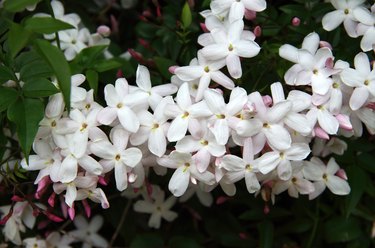
A jasmine (Jasminum spp.) with its intoxicating scent should have green leaves, at least during the growing season. If your jasmine leaves are turning yellow, they may just be preparing to drop off at the end of the season, or there may be a problem. Yellow leaves on jasmine plants and on most other shrubs and vines are usually easily diagnosed. Note that this is also true of the plant called "star jasmine," which is commonly considered jasmine but is actually a different genus, Trachelospermum.
Too Little or Too Much Water
Video of the Day
The primary cause of yellowing leaves is water — either too little or too much — and usually, it's the latter. Too much water can damage the roots so they can't take up nutrients. If your jasmine plants are in clayish soil or in a location that doesn't drain well, their roots may be standing in water.
Video of the Day
Alternatively, too little water can cause jasmine leaves to turn yellow. The basic reason is the same: Too little water damages the root structure, impairing its ability to soak up nutrients.
To avoid both these issues, ensure that your plants are located in porous, well-draining soil. When planting, add organic matter, which will improve soil texture and drainage. Before watering, poke your finger into the soil a few inches to test the moisture content. If dry, water thoroughly. If moist, hold off and test again a few days later.
Wrong Soil pH for Jasmines
When soil pH is off, a plant cannot absorb certain nutrients from the soil. This means that even if the soil is nutrient-rich, the plant cannot access them even if you fertilize.
Jasmine plants, whether they're pink or white jasmine, or some other cultivar, are not fussy about pH, growing easily in soils that range from slightly acid to slightly alkaline. Don't plant them in high acidic or alkaline soils at either side of the spectrum — but most home gardens already have a range of soil pH appropriate for jasmine. The upshot is that pH is probably not your problem but something of which to be aware.
Jasmines With a Nutrient Imbalance
A lack of the right nutrients is somewhat more difficult to diagnose. If it's a nitrogen deficiency, the plants have probably developed chlorosis, which results in the yellowing of leaves due to lack of chlorophyll. The most common culprit here is a lack of iron, although manganese or zinc can also play a role. Iron-based chlorosis starts on the younger or terminal leaves, slowly working inward on the plant to the older leaves. Manganese or zinc deficiencies tend to develop first on the older leaves.
A potassium deficiency can also be a factor. If the lower leaves are turning yellow and the stems appear weak, this could be the cause. The only real way to know if your jasmine is dealing with a nutrient deficiency is to have the soil tested. Contact your local university extension office for advice.
Jasmine Seasonal Changes
Some jasmine are evergreen, while some die back like perennials depending on your location. Even evergreen jasmine, like South African or Italian jasmine, will experience some yellowing of leaves over the winter until new growth develops. In this case, nothing is wrong. Just wait until spring and you should have a vibrant green-leafed jasmine again.
Be sure, however, that you have planted your jasmine within its USDA hardiness zone. The pink jasmine varieties are less hardy than winter varieties, such as J. nudiflorum, and may not make it through the winter. To prevent an early demise, you can try covering it with a frost blanket when the temperatures dip to freezing.